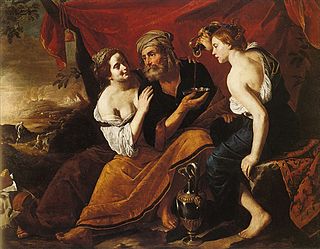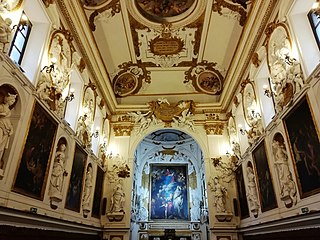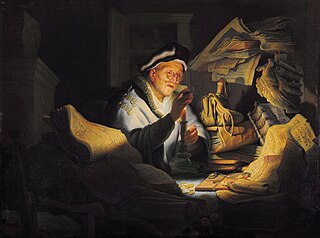
Antonio Allegri da Correggio, usually known as just Correggio was an Italian Renaissance painter who was the foremost painter of the Parma school of the High Italian Renaissance, who was responsible for some of the most vigorous and sensuous works of the sixteenth century. In his use of dynamic composition, illusionistic perspective and dramatic foreshortening, Correggio prefigured the Baroque art of the seventeenth century and the Rococo art of the eighteenth century. He is considered a master of chiaroscuro.

Abraham Bloemaert was a Dutch painter and printmaker who used etching and engraving. He initially worked in the style of the "Haarlem Mannerists", but by the beginning of the 17th-century altered his style in line with the new Baroque style that was then developing. He mostly painted history subjects and some landscapes. He was an important teacher, who trained most of the Utrecht Caravaggisti.

Filippo Lippi, also known as Lippo Lippi, was an Italian painter of the Quattrocento and a Carmelite priest. He was an early Renaissance master of a painting workshop, who taught many painters. Sandro Botticelli and Francesco di Pesello were among his most distinguished pupils. His son, Filippino Lippi, also studied under him and assisted in some late works.

Jusepe de Ribera was a Spanish painter and printmaker. Ribera, Francisco de Zurbarán, Bartolomé Esteban Murillo, and the singular Diego Velázquez, are regarded as the major artists of Spanish Baroque painting. Referring to a series of Ribera exhibitions held in the late 20th century, Philippe de Montebello wrote "If Ribera's status as the undisputed protagonist of Neapolitan painting had ever been in doubt, it was no longer. Indeed, to many it seemed that Ribera emerged from these exhibitions as not simply the greatest Neapolitan artist of his age but one of the outstanding European masters of the seventeenth century." Jusepe de Ribera has also been referred to as José de Ribera, Josep de Ribera, and Lo Spagnoletto by his contemporaries, early historians, and biographers.

Utrecht Caravaggism refers to the work of a group of artists who were from, or had studied in, the Dutch city of Utrecht, and during their stay in Rome during the early seventeenth century had become distinctly influenced by the art of Caravaggio. Upon their return to the Dutch Republic, they worked in a so-called Caravaggist style, which in turn influenced an earlier generation of local artists as well as artists in Flanders. The key figures in the movement were Hendrick ter Brugghen, Gerrit van Honthorst and Dirck van Baburen, who introduced Caravaggism into Utrecht painting around 1620. After 1630 the artists moved in other directions and the movement petered out. The Utrecht Caravaggisti painted predominantly history scenes and genre scenes executed in a realist style.
Sano di Pietro or Ansano di Pietro di Mencio (1405–1481) was an Italian painter of the Sienese school of painting. He was active for about half a century during the Quattrocento period, and his contemporaries included Giovanni di Paolo and Sassetta.
A doubting Thomas is a skeptic who refuses to believe without direct personal experience.

Bartolomeo Cavarozzi (1587–1625), occasionally referred to as Bartolomeo Crescenzi, was an Italian caravaggisti painter of the Baroque period. Cavarozzi's work began receiving increased admiration and appreciation from art historians in the last few decades of the 20th century, emerging as one of the more distinct and original followers of Caravaggio. He received training from Giovanni Battista Crescenzi in Rome and later traveled to Spain alongside his master for a few years where he achieved some renown and was significant in spreading "Caravaggism" to Spain before returning to Italy. His surviving works are predominantly Biblical subjects and still-life paintings, although older references note he "was esteemed a good painter especially of portraits".

Hendrick de Somer (1602–c.1655) was a Flemish painter who spent most of his life and career in Italy. He was mainly active in Naples.

Matthias Stom or Matthias Stomer was a Dutch, or possibly Flemish, painter who is only known for the works he produced during his residence in Italy. He was influenced by the work of non-Italian followers of Caravaggio in Italy, in particular his Dutch followers often referred to as the Utrecht Caravaggists, as well as by Jusepe de Ribera and Peter Paul Rubens. He did not share the other Northern Caravaggisti's preference for humorous, and sometimes scabrous, genre scenes and elaborate decorative allegories but favored stories from the bible instead. He worked in various locations in Italy where he enjoyed the patronage of religious institutions as well as prominent members of the nobility.

Jacques de l'Ange or the Monogrammist JAD was a Flemish painter and draughtsman known for his genre scenes and history paintings executed in a Caravaggesque style. The artist was only rediscovered in the mid-1990s as his work was previously attributed to other Northern Caravaggists and in particular the Utrecht School Caravaggists or Flemish Carravagists.

Saint Rosalie Interceding for the Plague-stricken of Palermo is a painting of 1624 by Anthony van Dyck, in the Metropolitan Museum of Art in New York since 1871.

The Oratory of the Rosary of Saint Dominic is a Baroque oratory of Palermo. It is located near the Church of Saint Dominic, in the quarter of the Loggia, within the historic centre of Palermo.

The Parable of the Rich Fool, also known as The Money Changer, is an oil painting on canvas of 1627 by Rembrandt, now in the Gemäldegalerie, Berlin. Produced early in the artist's career, it depicts the eponymous Biblical parable. The model for the figure is said to have been Rembrandt's father.

Supper at Emmaus is an undated oil on canvas painting by the Dutch or Flemish painter Matthias Stom. It was created when the artist was living in Rome, c. 1620-1640. It was bought by the town of Grenoble in 1826 and now hangs in Grenoble Museum. It depicts the scene described in the Gospel of Luke, when the Emmaus disciples recognize Jesus when He was breaking the bread.

King David is an oil on canvas painting by Matthias Stom, created c. 1633-1639, now held in the Musee des Beaux-Arts de Marseille. It is thought to have belonged to a set of four paintings of Old Testament kings. This group was itself part of a larger group of twelve works which also included the four Fathers of the Church and the four Evangelists, of which St Mark, St John and St Ambrose are now in the Musee des Beaux-Arts de Rennes.

The Judgement of Solomon is an oil on canvas painting by Matthias Stom, created c. 1640, of the Judgement of Solomon, now in the Currier Museum of Art in Manchester, New Hampshire, which purchased it from the J.E. Safra collection at Sotheby's on 5 July 2017 for £428,750. Its palette, style and drapery are similar to other works painted by the artist while on Sicily such as The Stoning of St Stephen, now in the Palazzo Alliata Villafranca in Palermo - the artist settled on the island around 1640.

Salome Receives the Head of John the Baptist is an oil on canvas painting by Dutch artist Matthias Stom, probably painted around 1630–1632 in Rome. It is now held in the National Gallery, in London, to which it was presented by the Trustees of Sir Denis Mahon's Charitable Trust via the Art Fund in 2013.

The Incredulity of Saint Thomas is an oil painting on canvas by Matthias Stom, created c. 1640-1649. It is held in the Museo del Prado, in Madrid.

Saint Maurice is an oil tempera on beech board painting by Bohemian painter Master Theodoric, created around 1360-1365. It is probably the first depiction of a black man in Czech painting. The extraordinary importance of this knight in the conception of the Chapel of the Holy Cross is evidenced by the portrait's placement in the main space of the presbytery adjacent to the painting of St. George and the Bohemian patron saint St. Vitus.


















